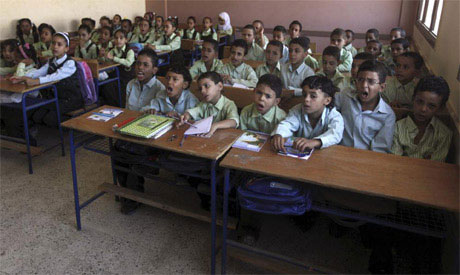
File Photo: Students attend class on the first day of their new school year at a government school in Giza, south of Cairo, September 22, 2013 (Photo: Reuters)
Some75 percent of Egyptian students sit in overcrowded classrooms with more than 40 students, and in other cases schools operate in a multiple-shift system, where students’ learning time is cut in half, a policy paper published on Wednesday by Alternative Policy Solutions, a research project of the American University in Cairo said.
The paper, published on the occasion of the beginning of the second academic semester and was prepared by Hania Sobhy, expert on education policies in the Middle East and a fellow researcher at Max Planck Institute MMG - MPG, said that over-density negatively impacts the general output of the educational process as well as the student’s ability to learn, especially in the primary stage, where the average classroom density stands at 47.5 students.
"Reforming Egypt’s current school construction system does not necessarily require building new schools. In fact, in the past few years, schools have been built where they were not actually needed, whereas areas with the direst need were neglected," the paper said.
It also illustrated that the inadequate learning conditions, compounded by sanitary and maintenance problems, disproportionately affect those students who are already disadvantaged and aggravates inequality in educational opportunities based on geographic location and economic status.
Dealing with such a serious conditions, the paper recommended to reduce costs by restructuring the General Authority for Educational Buildings, reforming financial regulations and spending more on maintenance, basing construction plans on a new set of indicators and building larger urban schools and smaller rural schools.
It also suggested upgrading disbursement system and to spend more on current schools' maintenance.
Short link: